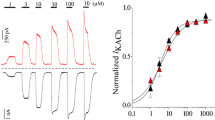Summary
Binding to muscarinic receptors was compared with adenylate cyclase inhibition in membranes derived from human heart auricles, and with inhibition of the contraction of auricular muscle fibers.
In the absence of GTP, agonists recognized two classes of receptors both of which bound antagonists with the same affinity. In the presence of GTP, both classes of receptors for agonists were converted into a single low affinity state.
Carbachol and oxotremorine inhibited adenylate cyclase activity by 43%, pilocarpine being less efficient (−28%). The 3 agonists exerted similar inhibitory effects on the inotropic response, in 7 out of 9 preparations of electrically- and norepinephrine-stimulated fibers. Dose-effect curves suggested that spareness (or an amplification mechanism) was implicated in the occupancy of low affinity binding sites by carbachol and oxotremorine (but not by the partial agonist pilocarpine) and the resulting inhibition of both adenylate cyclase activity and contractile force.
Similar content being viewed by others
Abbreviations
- [3H] NMS, [N-methyl-3H]:
-
scopolamine methyl chloride
- Gpp(NH)p:
-
guanosine 5′-0-(2-3 imido) triphosphate
- EGTA:
-
ethylene glycol bis (2-aminoethyl ether)-N,N,N′,N′-tetraacetic acid
References
Ariëns EJ, Van Rossum JM, Koopman PC (1960) Receptor reserve and threshold phenomena. I. Theory and experiments with autonomic drugs tested on isolated organs. Arch Int Pharmacodyn 127:459–478
Berrie CP, Birdsall NJM, Burgen ASV, Hulme EC (1979) Guanine nucleotides modulate muscarinic receptor binding in the heart. Biochem Biophys Res Commun 87:1000–1005
Biegon RL, Pappano AJ (1980) Dual mechanism for inhibition of calcium depender action potentials by acetylcholine in avian ventricular muscle. Relationship to cyclic AMP. Circ Res 46: 353–362
Brown JH (1979) Cholinergic inhibition of catecholamine-stimulable cyclic AMP accumulation in murine atria. J Cycl Nucl Res 5:423–433
Cavey D, Vincent JP, Lazdunski M (1977) The muscarinic receptor of heart cell membranes: association with agonists, antagonists and antiarrhythmic agents. FEBS Lett 84:110–114
Cheng YC, Prusoff WH (1973) Relationship between the inhibition constant (K i) and the concentration of inhibitor which causes 50 percent inhibition (I50) of an enzymatic reaction. Biochem Pharmacol 22:3099–3108
Ehlert FJ, Roeske WR, Yamamura HI (1981) Muscarinic receptor: regulation by guanine nucleotides, ions and N-ethylmaleimide. Fed Proc 40:153–159
Fields JZ, Roeske WR, Morkin E, Yamamura HI (1978) Cardiac muscarinic cholinergic receptors: biochemical identification and characterization. J Biol Chem 253:3251–3258
Gardner JD (1979) Receptors for gastrointestinal hormones. Gastroenterology 76:202–214
Jakobs KH, Aktories K, Schultz G (1979) GTP-dependent inhibition of cardiac adenylate cyclase by muscarinic cholinergic agonists. Naunyn-Schmiedeberg's Arch Pharmacol 310:113–119
Jakobs KH, Aktories K, Schultz G (1981) Inhibition of adenylate cyclase by hormones and neurotransmitters. In: Dumont JE, Greengard P, Robinson GA (eds) Advances in cyclic nucleotide research, vol 14. Raven Press, New York, pp 173–187
Keely SL, Lincoln TM (1978) On the question of cyclic GMP as the mediator of the effects of acetylcholine on the heart. Biochim Biophys Acta 543:251–257
Keely SL, Lincoln TM, Corbin JD (1978) Interaction of acetylcholine and epinephrine on heart cyclic AMP-dependent protein kinase. Am J Physiol 234:H432-H438
Levy MN (1971) Sympathetic-parasympathetic interactions in the heart. Circ Res 29:437–445
Lichtshtein D, Boone G, Blume A (1979) Muscarinic receptor regulation of NG 108-15 adenylate cyclase: requirement for Na+ and GTP. J Cycl Nucl Res 5:367–375
Lowry OH, Rosebrough NJ, Farr AL, Randall RJ (1951) Protein measurement with the Folin phenol reagent. J Biol Chem 193: 265–275
Minneman KP, Hegstrand LR, Molinoff PB (1979) Simultaneous determination of beta 1 and beta 2 adrenergic receptors in tissues containing both receptor subtypes. Mol Pharmacol 16:34–46
Murad F, Chi YM, Rall TW, Sutherland EW (1962) Adenyl cyclase. III. The effect of catecholamines and choline esters on the formation of adenosine 3′,5′-phosphate by preparations from cardiac muscle and liver. J Biol Chem 237:1233–1238
Nomura Y, Kajijama H, Segawa T (1979) Decrease in muscarinic cholinergic response of the rat heart following treatment with 6-hydroxydopa. Eur J Pharmacol 60:323–327
Pappano AJ, Hartigan PM, Coutu MD (1982) Acetylcholine inhibits positive inotropic effect of cholera toxin in ventricular muscle. Am J Physiol 243:H434-H441
Robberecht P, Waelbroeck M, Claeys M, Nguyen Huu A, Chatelain P, Christophe J (1982) Rat cardiac muscarinic receptors. II. Influence of thyroid status and cardiac hypertrophy. Mol Pharmacol 21:589–593
Rosenberger LB, Roeske WR, Yamamura HI (1979) The regulation of muscarinic cholinergic receptors by guanine nucleotides in cardiac tissue. Eur J Pharmacol 56:179–180
Salomon Y, Londos C, Rodbell, M (1974) A highly sensitive adenylate cyclase assay. Anal Biochem 58:541–548
Scatchard G (1949) The attraction of proteins for small molecules and ions. Ann Acad Sci NY 51:660–672
Takeyasu K, Uchida S, Ueda A, Maruno M, Lai RT, Hata F, Yoshida H (1979) Experimental evidence and dynamic aspects of spare receptors. Life Sci 25:1761–1772
Ten Eick R, Nawrath H, McDonald TF, Trautwein W (1976) On the mechanism of the negative inotropic effect of acetylcholine. Pflügers Arch 361:207–213
Waelbroeck M, Robberecht P, Chatelain P, Christophe J (1981) Guanine nucleotide binding sites responsible for adenylate cyclase activation and carbamylcholine binding inhibition shown similar properties in rat heart membranes. J Cyclic Nucl Res 7:173–185
Waelbroeck M, Robberecht P, Chatelain P, Christophe J (1982) Rat cardiac muscarinic receptors. I. Effects of guanine nucleotides on high- and low-affinity binding sites. Mol Pharmacol 21:581–588
Watanabe AM, McConnaughey MM, Strawbridge RA, Fleming JW, Jones LR, Besch HR Jr (1978) Muscarinic cholinergic receptor modulation of β-adrenergic receptor affinity for catecholamines. J Biol Chem 253:4833–4836
Wei JW, Sulakhe PV (1979) Agonist-antagonist interactions with rat atrial muscarinic cholinergic receptor sites: differential regulation by guanine nucleotides. Eur J Pharmacol 58:91–92
Wei JW, Sulakhe PV (1980) Cardiac muscarinic cholinergic receptor sites: opposing regulation by divalent cations and guanine nucleotides of receptor-agonist interaction. Eur J Pharmacol 62:345–347
Author information
Authors and Affiliations
Rights and permissions
About this article
Cite this article
Delhaye, M., De Smet, J.M., Taton, G. et al. A comparison between muscarinic receptor occupancy, adenylate cyclase inhibition, and inotropic response in human heart. Naunyn-Schmiedeberg's Arch. Pharmacol. 325, 170–175 (1984). https://doi.org/10.1007/BF00506197
Received:
Accepted:
Issue Date:
DOI: https://doi.org/10.1007/BF00506197




